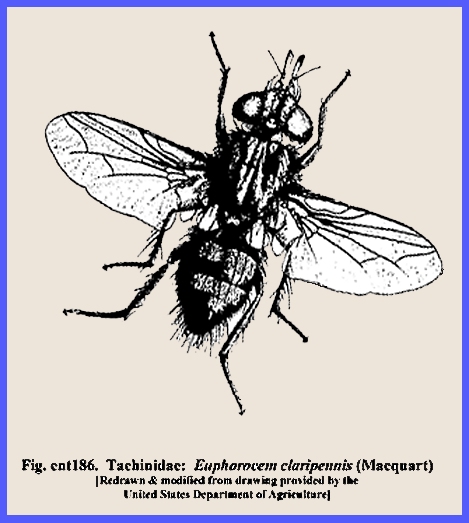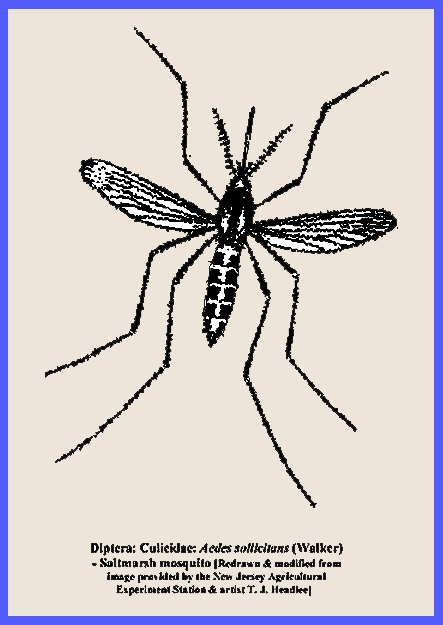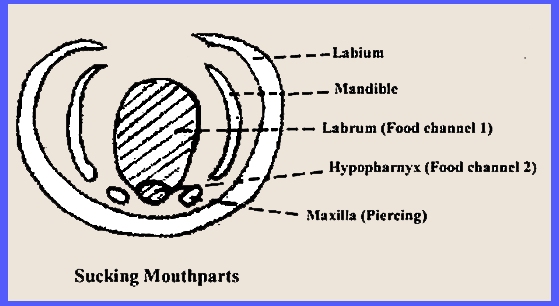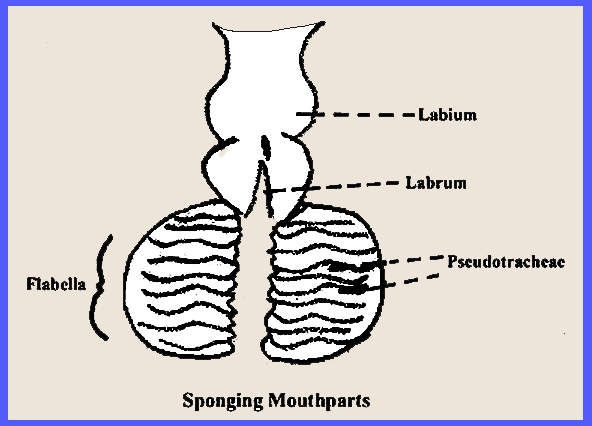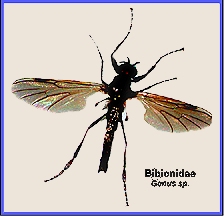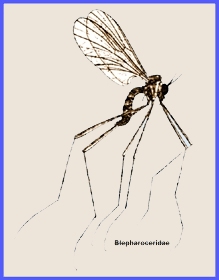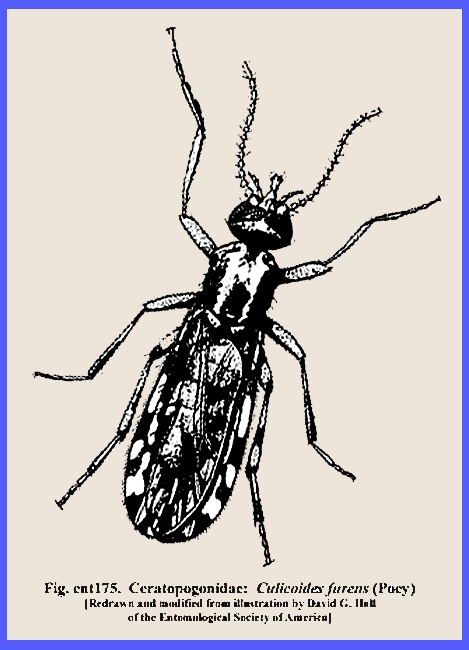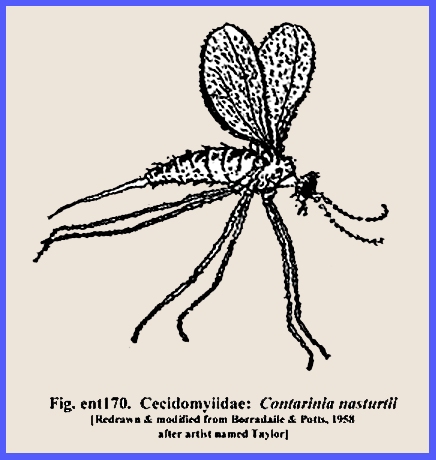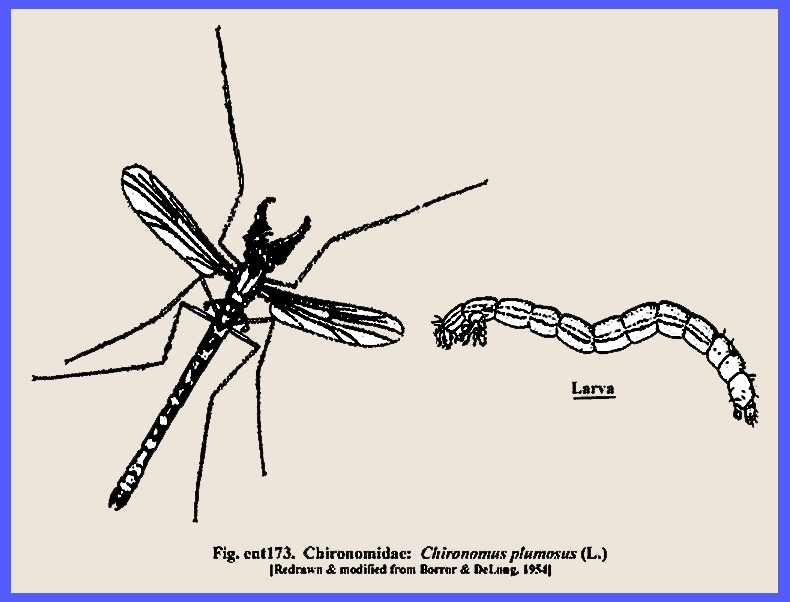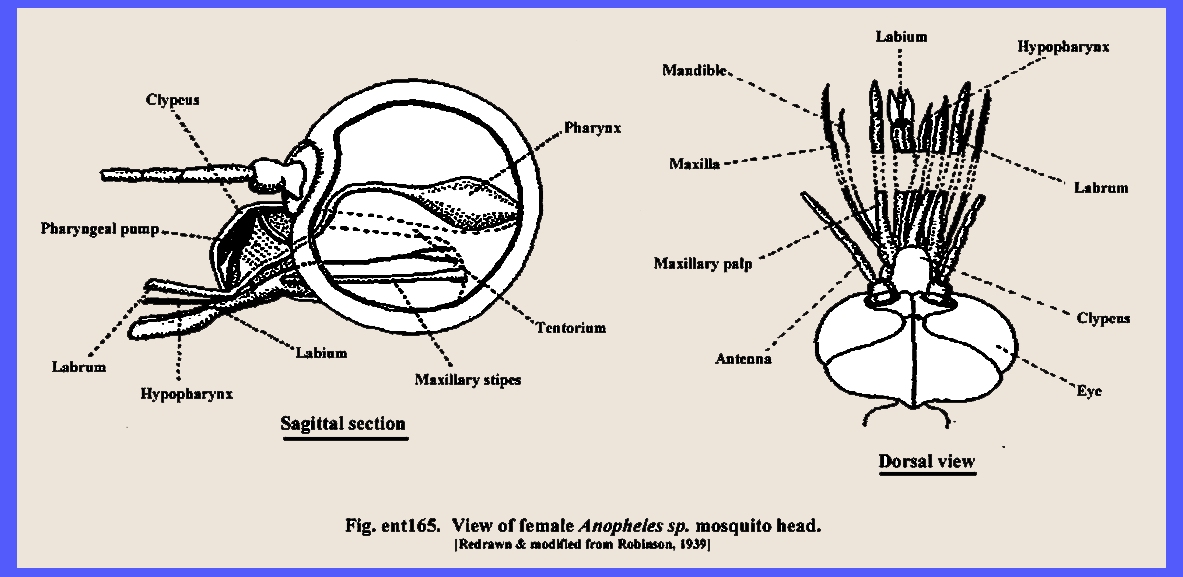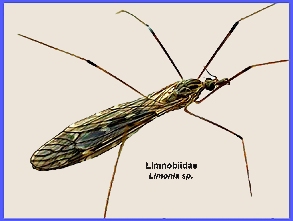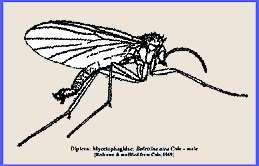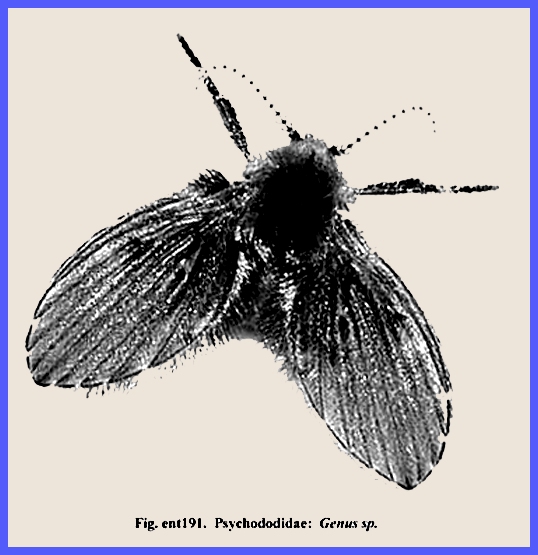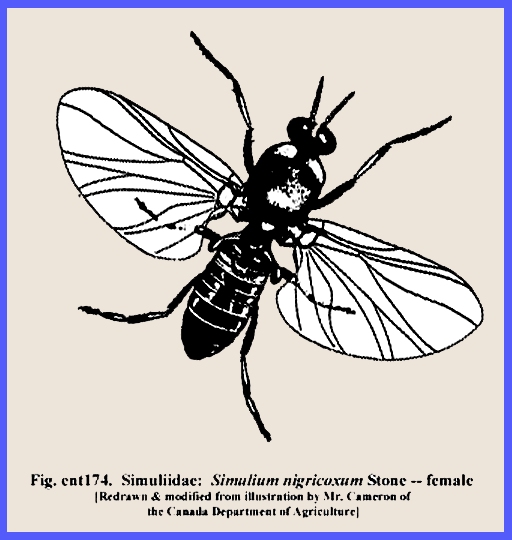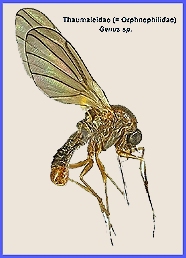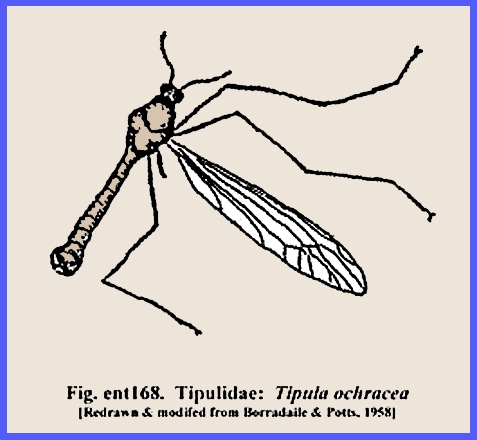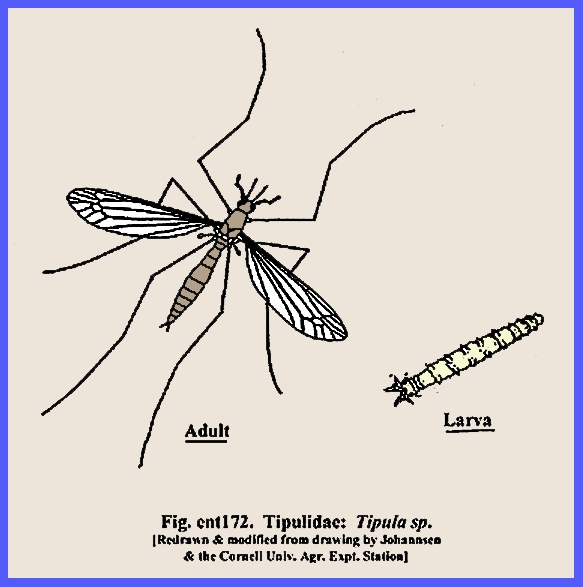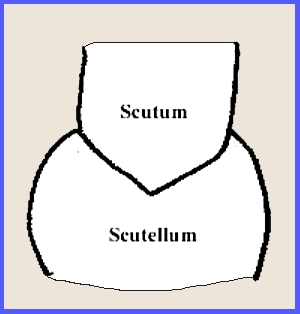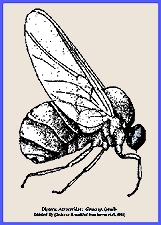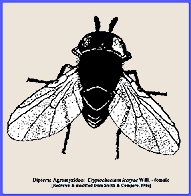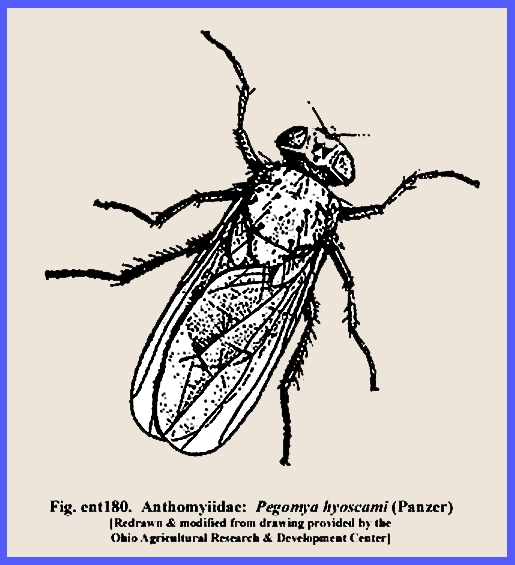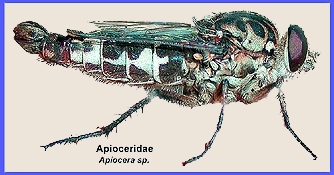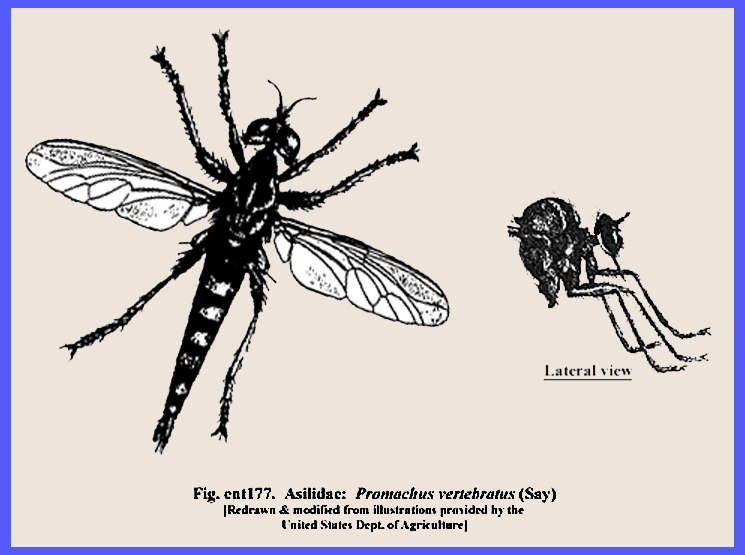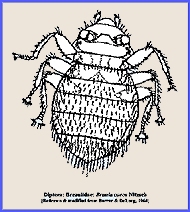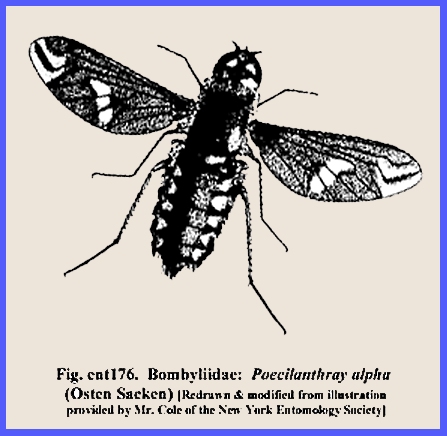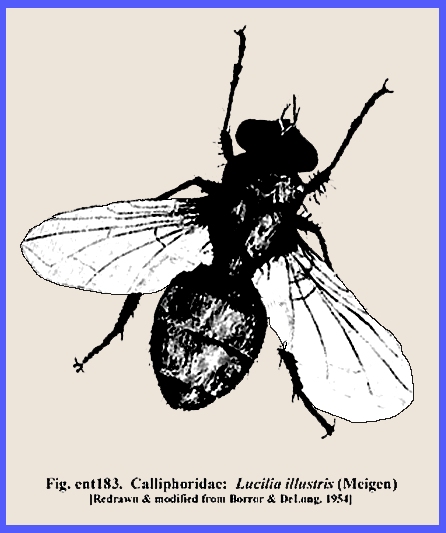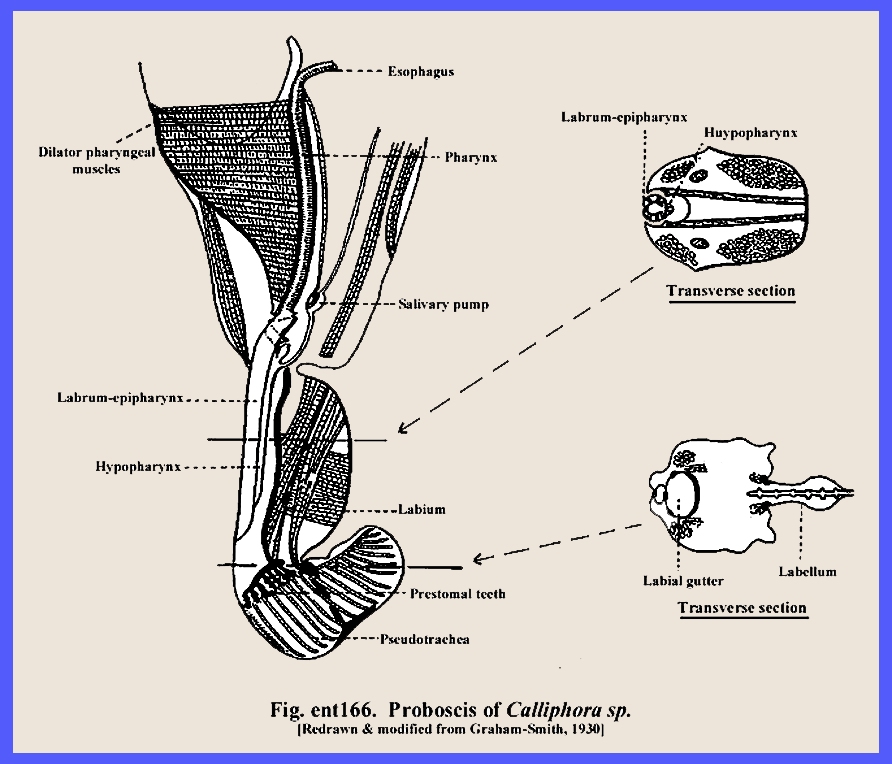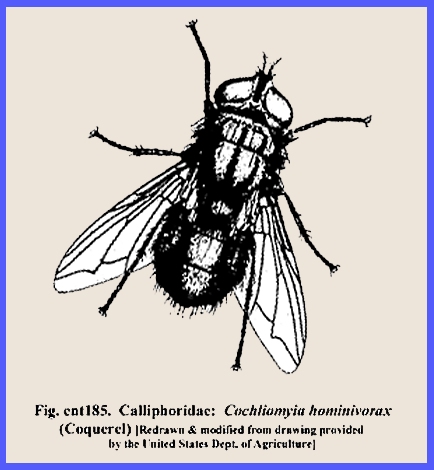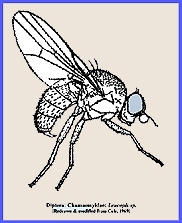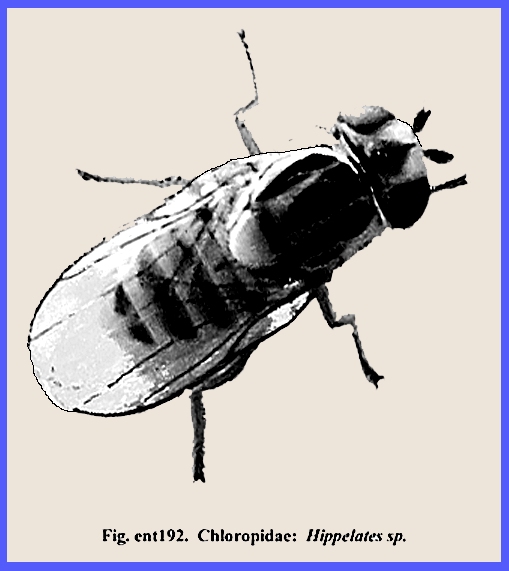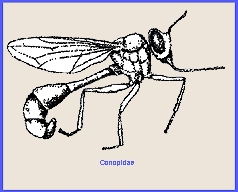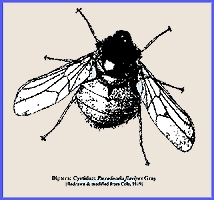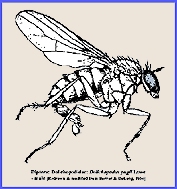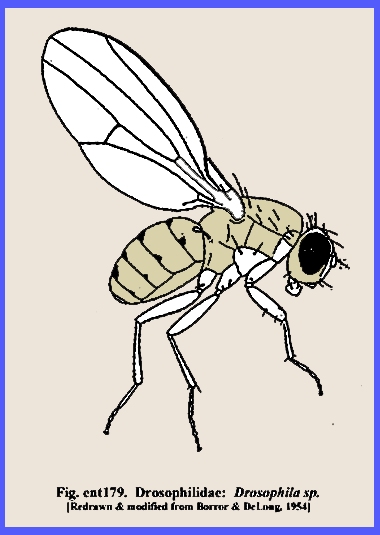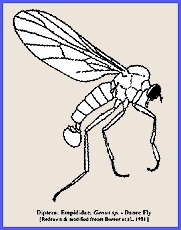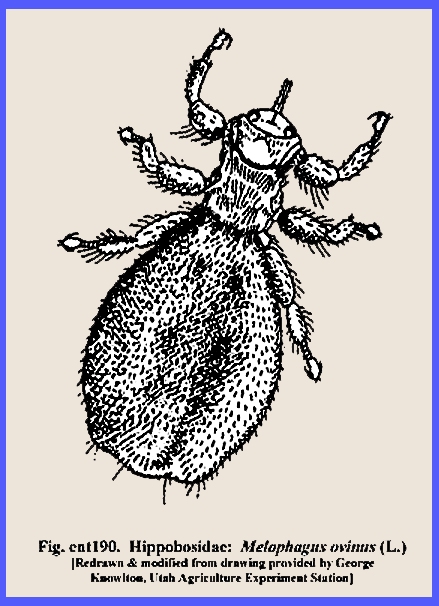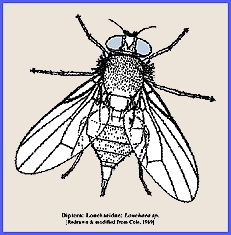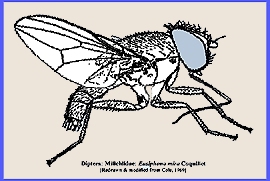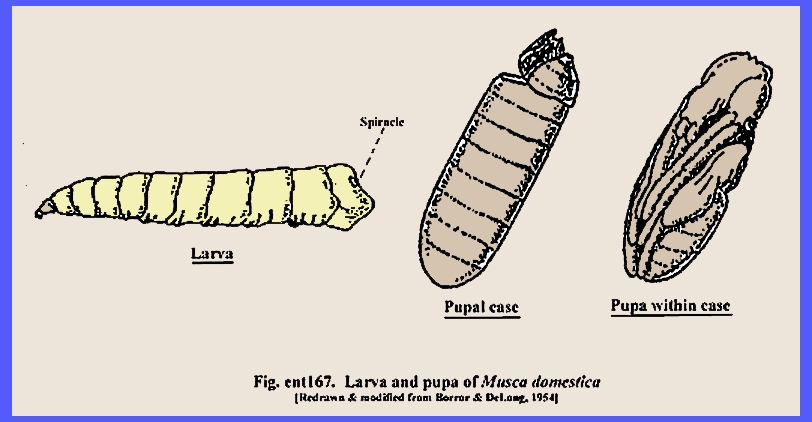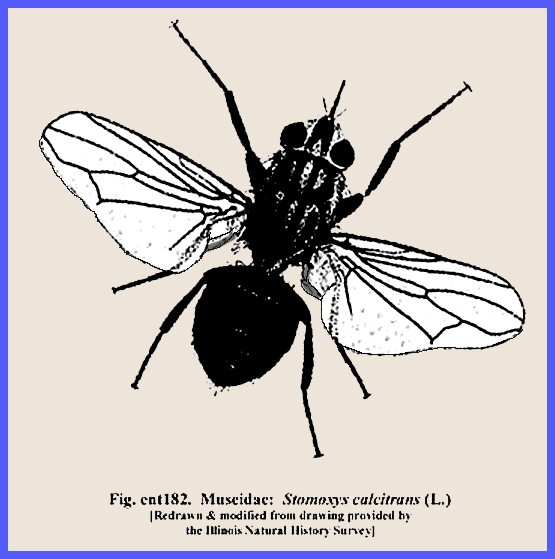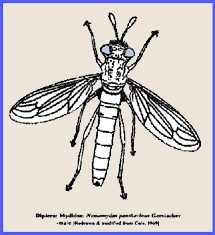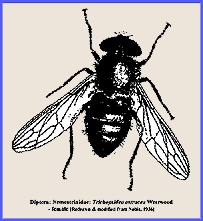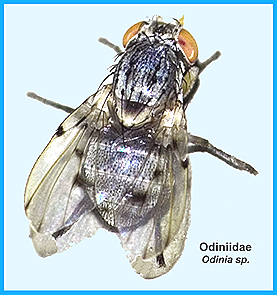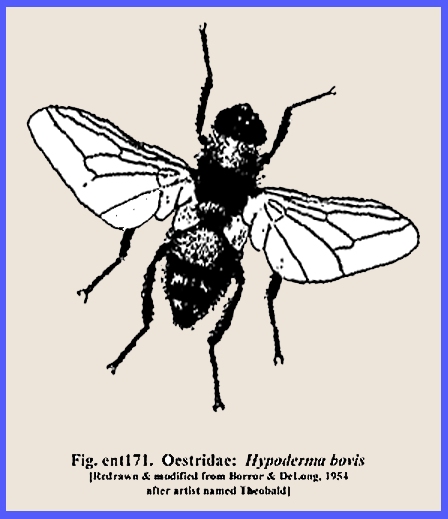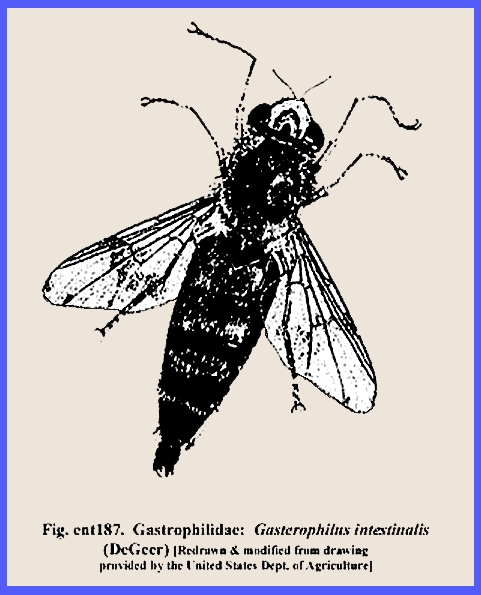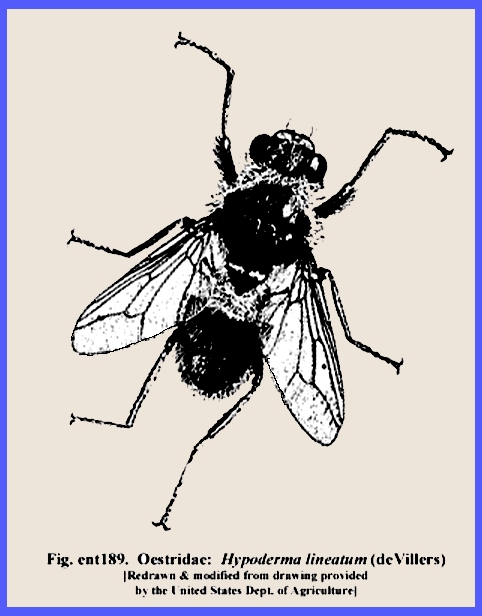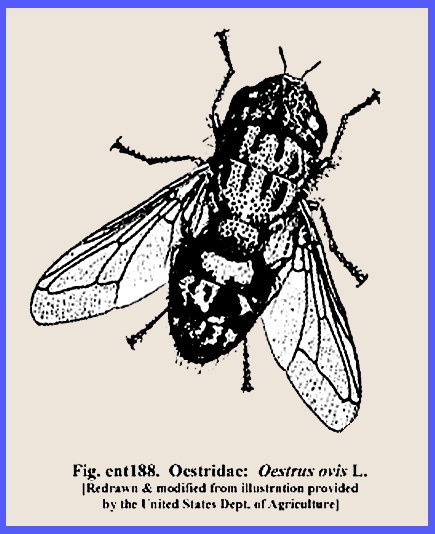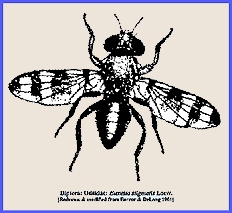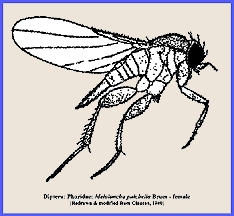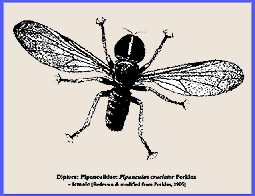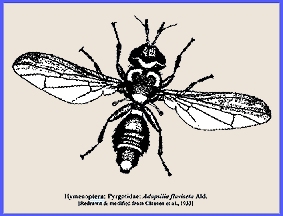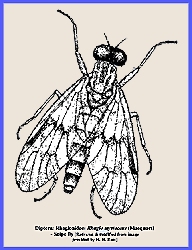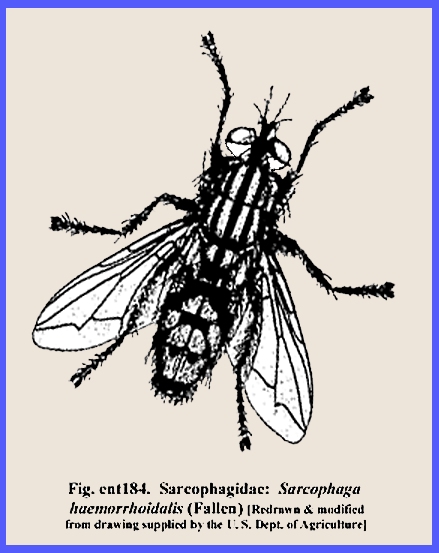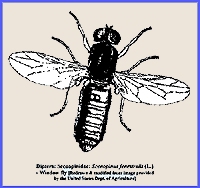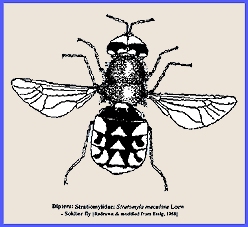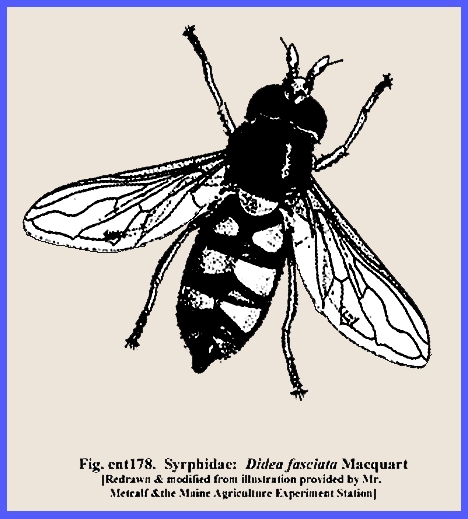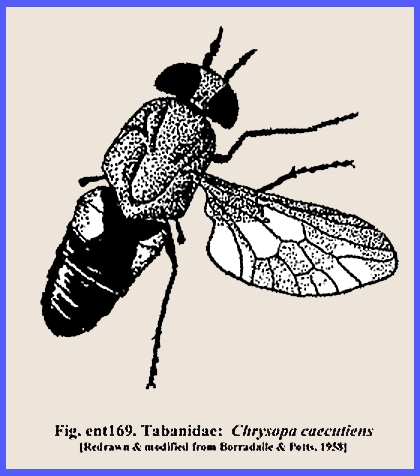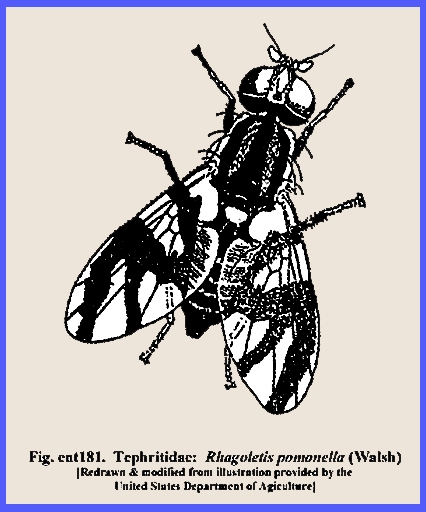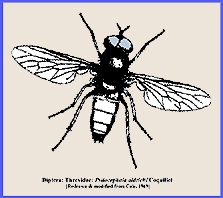File:
<diptera.htm> Indexes: <
(Entomology),
(Invertebrates), (General Index)> <Invertebrate Bibliography> <Glossary> <Site Description> < Home>
|
Entomology: DIPTERA
1 Kingdom: Animalia, Phylum: Arthropoda Subphylum: Hexapoda: Class: Insecta: Order:
Diptera (Contact) Please CLICK on underlined
categories to view and on included illustrations to enlarge: Depress Ctrl/F
to search for subject matter:
The Diptera
-- <General
Characteristics> <Juveniles>
-- have only one pair of functional wings, hence their name meaning
"Two-wing". The hind pair
of wings is reduced in size to highly sensory stumps or halteres. The mouthparts are usually suctorial but
sometimes piercing or biting, and elongated to form a proboscis. The prothorax and metathorax are small and
fused with the large mesothorax. They
have a complete metamorphosis. The
larvae are often worm-like and always without legs. Their head is usually small and retracted. The pupa is either free or enclosed in a
puparium that is made of the hardened last larval skin. [For terminology please refer to: Glossary] This is a very large and
specialized order of insects. The adults are mostly diurnal, feeding on the
nectar of flowers, but a number are predaceous living on other insects (e.g.
the robber-flies), while some, e.g. tachinids, are parasites. Several
families have acquired blood-sucking habits, the representatives of which are
of great importance because they harbor and transmit pathogenic organisms,
causing such diseases as malaria, sleeping sickness, elephantiasis, yellow
fever and some cattle fevers.
The food tube is formed mostly by
the conjoined labrum-epipharynx and the hypopharynx, and at the lower end of
the labrum where the latter structures do not reach the full distance. The overlapping sides of the labial groove
form a food tube. In this way food
collected at the median part of the pseudotracheal membrane to which the
pseudotracheae converge is brought into contact with the food tube and so
with the pharynx. Calliphora feed largely on
fluids, but in the presence of soluble solid food the groove solution is
affected by regurgitating alimentary fluid onto it. In other cases the
prestomal teeth can abrade temporarily dried surfaces and so bring the
regurgitated fluids more effectively into contact with the food material.
When the labellae are completely retracted food enters the wide-open food tube
irrespective of the pseudotracheae and the passage is then large enough for
semisolid food or even the eggs of helminths to enter (Borradaile
& Potts, 1958). It has been suggested that in the
evolution of the Diptera there has been a trend towards surface fluid feeding
involving the loss of piercing stylets. However, there are forms, closely
related to the blowfly type in which mandibular and maxillary stylets are
lacking, but which can pierce the skins of mammals, using the labium., e.g.,
the tsetse fly Glossina and the
stable fly Stomoxys. In these cases the labium has become so
rigid that it cannot be folded under the head. Therefore, with its contained
labrum-epipharynx and hypopharynx, it extends stiffly forwards. The labellar
apparatus is reduced and consists of three small, stout lobes that bear
rasping teeth, some of which represent the prestomal teeth of Calliphora Diptera larvae are among the most
specialized of all insects. Legs have been entirely lost, and
the head and spiracular system have undergone varying degrees of reduction.
Thus the most generalized larvae are at the same time eucephalous, i.e.
with a complete head capsule, and peripneustic, i.e. with the lateral
spiracles on the abdomen, e.g. Bibio. In the most specialized forms,
the acephalous larva's head capsule is absent, e.g. Musca. Such
acephalous larvae may either be amphipneustic, with only prothoracic
and posterior abdominal spiracles, or metapneustic, where only two spiracles
exist at the posterior end of the body. The first instar larva of Musca is
metapneustic, subsequent instars being amphipneustic.
The Suborder
Orthorrhapha includes those flies which are liberated by means of a
longitudinal split in the mid-dorsal line of the pupal case Such flies do not have a ptilinum. Many of
these, the Nematocera, have slender antennae and usually pendulous maxillary
palpi. Their larvae are eucephalous
with transversely biting mandibles and their pupae are free. To this series
belong the crane flies the larvae of which often damage cereal crops by
devouring their roots. The Culicidae are the gnats and mosquitoes, the
piercing proboscis of which has already been described. Their wings that are
fringed with scales further distinguish them. Both larvae and pupae are
aquatic, the former being metapneustic, the latter propneustic (with
anterior spiracles only). With the blood-sucking habit of these flies has
evolved an association with certain organisms that when, transmitted to
humans, cause disease. Anopheles is concerned with the transmission of
malaria. Stegomyia transmits the pathogen of yellow fever, while Culex
fatigans, a widely distributed tropical form, is a carrier of the
threadworm Wuchereria bancrofti, the cause of elephantiasis.
From this great assemblage of
flies the Tabanidae or gadflies, the mouthparts of which reference has
already been made, are of stout build and possess large eyes occupying a
great part of the head surface. Though a few transmit disease organisms (Chrysops
dimidiata, as the vector of the nematode worm Loa loa, is
responsible for calabar swelling in the natives of West Africa), the majority
are harmful chiefly through the annoyance that their bites cause. Tabanid
eggs are usually laid on the leaves of plants overhanging water and their
carnivorous larvae are either aquatic or ground-dwellers. The robberflies (Asilidae) are
large hairy flies with a proboscis that is pointed to the rear. They feed on
all kinds of insects that they paralyze with their salivary fluid, and their
legs, which are strong and equipped with powerful claws, are well adapted for
grasping the prey. The Empidae, flies of more slender build, exhibit
similar habits. Their larvae are terrestrial as are also those of the
preceding tabanids. The Suborder Cyclorrhapha are
flies that emerge from a pupa which is enclosed in the last larval skin or
puparium, and the commonly transverse or circular split in the latter, for
release of the adult, gives the name to this suborder. Therefore, it is really a characteristic
of the larvae that establishes the position of these flies in the
classification.
= = = = = = = = = = = = =
= = = = = = = = = All species of Diptera have two
wings, the hind ones being reduced as remnants to halteres, which vibrate in
flight to act as a kind of gyroscope.
This aids them in very rapid and agile flight. There are many aquatic larvae and their
size ranges from minute to 16 centimeters long. The larvae are maggots with very few appendages. There is much mimicking of wasps and bees
found in the order. The Diptera are
important for their annoyance to or feeding on humans and animals, being
disease carriers and some species are also injurious to plants. The order is
especially homogenous and is divided into to principal groups: 1. Nematocera have
antennae with distinct segments varying from 5-30. Most larvae have a distinct head capsule, and the tentorium is
developed so that the mandibles are opposable. 2. Brachycera have
antennae with a reduced 3-4 segments.
The head capsule is very much lost, and the larvae are worm-like
maggots. The mouthparts are developed
as hooks and function by moving up and down. Other divisions for
Diptera are Orthorrhapha and Cyclorrhapha as follows: 3. Orthorrhapha is a circumscriptional
name which historically was used for an infraorder of Brachycera, one of the
two suborders into which the order Diptera, the flies, are divided. As the
group was paraphyletic, it has not been used in classifications in the last
decade, and is effectively obsolete. However, many catalogs, checklists, and
older works still contain the name. The taxa that used to be in the
Orthorrhapha now comprise all of the infraorders in Brachycera excluding the
Muscomorpha (= "Cyclorrhapha"). A recent revision of the taxonomy
of the order Diptera revived the name Orthorrhapha. 4. Cyclorrhapha is
an unranked taxon within the infraorder Muscomorpha. They are called
"Cyclorrhapha" ('circular-seamed flies') with reference to the
circular aperture through which the adult escapes the puparium. This is a
circumscriptional name that has significant historical familiarity, but in
the present classification, this name is synonymous with the more recent
"Muscomorpha/" Cyclorrhapha
underwent major adaptive radiation that led to the creation of over 72 000
species. These species share multiple attributes such as the 360-degree
rotation of the male terminalia. ---------------------------------------------- Mouthparts. -- There are three types
found in adults: (1) nectar-feeding
or sucking, (2) sucking-lapping or sponging and (3) true blood sucking that
are rasping sucking. Simplified diagrams
of these types are shown in the following: Sucking
(mosquito) Sponging
(housefly
Rasping-sponging (horsefly) Larval
Spiracular Arrangement. -- The spiracles of dipterous larvae may
be arranged in either of four ways:
(1) peripneustic,--
lateral spiracles on the abdomen. (2) amphipneustic--
only prothoracic and posterior abdominal spiracles present, (3) metapneustic-- only two spiracles
are retained at the posterior end of the body. (4) propneustic -- lateral spiracles on the thorax. Pupal Spiracles.
-- In many species the spiracles of pupae are moved to the head and
thorax. Here they appear as "pupal horns." =
= = = = = = = = = = = = = = = = = The following discussion includes only
the most common or important families of Diptera. For greater detail please
refer to Borror et al. (1989),
and for an expanded treatment of Diptera taxonomy with 125 families noted
please see: <207
Families>. Additional information on <Habits>,
<Adults> and <Juveniles>
is included when available. Nematocera = "long
antennae." Bibionidae. -- Bibionidae have a body length of about
4-10 mm. The body is black, brown, or reddish, and heavy, with broad legs.
Antennae are miliform and the front tibiae have large spurs or spines. The
tarsi have 5 segments with tarsal claws, pulvilli, and a well formed
empodium. Wings have two basal cells (posterior basal wing cell and basal
wing cell), but there is no discoidal wing cell. R4+5 is simple or branched; at most, only three branches of R
developed. The front edge wing veins are thicker than the trailing veins. The larvae inhabit grassy areas
where they feed on dead vegetation or living plant roots. Larvae are sometimes also found in pockets
with many others. Adults of most Plecia
and some species of Bibio do not eat, but rely on the food of the
larval stage. Adults are
short-lived, and some species of Plecia (lovebugs) spend much of their
adult lives copulating. The male and
female (attach themselves
at the rear of the abdomen and remain that way at all times, even in flight.
Adults often swarm in large numbers. --------------------------------- Blepharoceridae.
-- <Adults> & <Juveniles> Members of this family are largely or entirely aquatic in
habit. The larvae feed in part on
minute organisms such as diatoms and on small Crustacea. Adults feed extensively on midges and
other small, soft-bodied insects. --------------------------------- Ceratopogonidae
(Heleidae).
-- <Habits>; <Adults> The
Biting midges, Punkies
and No-see-ums are biting flies, with the
Genera Culicoides
and Leptoconops being especially problematic. Most species are very small and stout, with rather broad wings
that they hold flat over their abdomen when resting. They are very pestiferous due to their
habits of sucking blood from animals including other insects. The bites often
result in painful swellings. Some
species may be recognized by their spotted wings. The primary habitat is along the
seacoast and the shores of lakes and rivers.
The larvae are aquatic or semiaquatic in the sand, decaying vegetation
or mud and in tree holes containing water.
Breeding along the seacoast is possible in the intertidal zone. Their
habit of remaining close to the larval developmental sites allows one to
simply move a short distance away to avoid being attacked. --------------------------------- Cecidomyiidae.
-- <Habits>; <Adults> & <Juveniles>
-- The gall midges
or gall gnats have larvae that occur in plant tissues. One important species, the Hessian
Fly, Mayetiola
destructor (Say), attacks
wheat stems in the larval stage. It
was introduced into North America during the Revolutionary War with the
Hessian insurgents. It is an
important pest of wheat, barley, rye and some wild grasses. Injury is caused when the larvae burrow
into stems, which results in stunted grain and sometimes in the death of the
plant. The puparia overwinter in the
grain. There are one or two
generations per year. Control has
involved planting wheat so that it germinates after danger of infestation is
past, deep plowing grain stubble and reducing volunteer grain. The genus Miastor
is one of the few examples of paedogenesis. The larvae give birth to progeny. They produce eggs, which produce more
larvae that also may produce eggs, etc. --------------------------------- Chironomidae.
-- <Habits>; <Adults> & <Juveniles>
-- The Midges
also appear as very large
mosquitoes, but they do not bite humans or animals. The male antennae are usually conspicuously plumose. They are one of the most abundant and
important foods for fish in freshwater habitats worldwide. Most species are small and resemble
mosquitoes but lack scales on their wings and are without a long proboscis. The larvae of most members are
aquatic, but several species also occur in decaying vegetable matter, under
tree bark or in moist soil. Most are
scavengers. Aquatic species usually
form tubes or cases in which they are protected. Some species are red in color from the hemoglobin in their
blood, hence their name, "bloodworms."
The larvae may exist at varying depths in water, and they swim by
whipping their bodies similar to that of mosquitoes. Chironomids pose an annoyance
because of the male's swarming habits.
However, they are an important food source for freshwater fish and
other aquatic inhabitants. --------------------------------- Culicidae.
-- <Habits>; <Adults> & <Juveniles>
-- The Mosquitoes
are identifiable by having
scales present as patches on their wings.
Only the female mosquito is capable of sucking blood. The eggs are laid in water and the pupae
are capable of locomotion. There are two groups: The Anophelines and Culicines: The wings are spotted with
definite patches of scales. Their
feeding position is at a 45-degree angle with the surface. The aquatic larvae feed horizontal with
the water film due to short terminal spiracles. Members of the genus are the sole vectors of malaria. They have long palpi and the eggs are laid
singly. The wings are not spotted and mostly entirely clear. The feeding position angle is primarily
horizontal with the surface. The
aquatic larvae have developed an elongated siphon and feed hanging down from
the water surface at an angle.
Members of the genus include the common pest mosquitoes, which carry
many viruses such as yellow fever, dengue, encephalomyelitis and the filarial
worm. They have short palpi and the
eggs are laid in masses. --------------------------------- Limnobiidae. -- <Habits>; <Adults> & <Juveniles>
Members of this family are largely or entirely
aquatic in habit. The larvae feed in part
on minute organisms such as diatoms and on small Crustacea. ---------------------------------
Mycetophilidae. -- <Habits>; <Adults> & <Juveniles>
The
Mycetophilidae or "fungus gnats" are a family of small flies. There are about 3000 described species in
150 genera, but the actual number of species is probably higher. They generally occur in the damp habitats
of their host fungi
and sometimes form dense swarms. Adults of this family are distinguished
from other small flies by a pronounced humped thorax,
well-developed coxae, and often spiny legs. However
identification within the family between genera and species requires close
study of microscopic features in wing venation and variation in chaetotaxy
and genitalia. Larvae
are terrestrial and usually feed on fruiting bodies, hyphae and spores of
fungi, but some species have been observed on mosses and liverworts. The larvae of some species, are also
partially predatory. Some species when attracted to the fungus
odor of Jack-in-the-Pulpit, fall into the
inflorescences and accomplish pollination. --------------------------------- Psychodidae.
-- The Moth flies and sand flies
have abundant scales on their wings. They
are small to very tiny insects with a large number of hairs on their
bodies. When at rest adults may hold
their wings roof like over the body. The habitat is in moist shady
areas but can also be found in drainages or sewers. Adults may occur in bathrooms that they enter via sink drains. Larvae inhabit decaying vegetable matter,
moss, mud or water. There are some medically important
species that are vectors of various fevers, such as Leishmania,
Pappataci
fever, Kala-azar and Oroya fever, especially in
tropical regions. --------------------------------- Simulidae.
-- The Black flies or Buffalo gnats
are biting flies that draw
blood, especially around the head region of humans and animals. Their color is generally dark and they
have short legs, broad clear wings with 4-5 veins. Their thorax is enlarged so that they appear hunch-backed. The females are bloodsuckers and can
become vicious biters. Their bites
may cause swelling or bleeding. In
some parts of North America blackflies become so numerous that their attacks
on livestock can cause death. Even
humans have succumbed. Indeed, in
areas of heavy infestation some communities hold "Blackfly
Festivals" in late springtime to "celebrate" the
end of the worst season of their occurrence. They are associated with moving
streams where the larvae develop underneath submerged stones to which they
attach themselves with a disk like sucker at the rear end of their body.. The larvae possess gills, attachment hooks
and characteristic respiratory horns.
Blackflies are vectors of animal
diseases, especially of poultry, in some parts of the world. Diseases include onchocerciasis caused by a
filarial worm, which may result in partial or complete blindness. --------------------------------- Thaumaleidae (=
Orphnephilidae) . -- <Habits>; <Adults> & <Juveniles>
Members of this family are mostly or entirely
aquatic in habit. The larvae feed in
part on minute organisms such as diatoms and on small Crustacea. --------------------------------- Tipulidae.
-- <Habits>; <Adults> & <Juveniles>
-- The Crane flies,
which contain the
largest number of species in the order,
are recognized by their long, spindly legs. They have the appearance of giant mosquitoes, but there are no
biting mouthparts in the adults. There is a distinct V-shaped
suture between the scutellum and scutum, and the adults lack ocelli. Their habitat is primarily in damp
areas with abundant vegetation, the larvae feeding in dead and decaying
vegetation. The larvae of most species
are aquatic or semi aquatic, and a few species feed on living plant tissue
and thereby may cause damage to crops.
There are even a few predatory species. Adults derive their nourishment from nectar. =
= = = = = = = = = = = = = Brachycera = "short
antennae" includes larger flies with large eyes. Acroceridae. -- <Habits>; <Adults> This is a small family of odd looking flies most closely related to Nemestrinidae.
There are about 520 species in 50 genera. They are characterized by a
humpbacked appearance and a small head, sometimes with a long proboscis for
nectar. As such, acrocerids are commonly known as small-headed flies or
hunchback-flies. Many are bee or wasp mimics. Their eyes are often holoptic;
their heads seem to be composed primarily of ommatidia. They are cosmopolitan
in distribution but rarely observed in most places; the majority of the over
500 species are known from fewer than 10 specimens. They are found most
commonly in semi-arid tropical locations. All small headed flies
are parasitoids of spiders. They are most commonly collected when a spider
from the field is brought into captivity. The adults do not seek out their
hosts; instead the first instar larvae is a planidium that seeks out spiders.
When a spider contacts an acrocerid planidium, the larva grabs hold of the
spider, crawls up the spider's legs to its body, and forces its way through
the body wall, often lodging near the book lung, where it may remain for
years before completing its development. Some obsolete names for Acroceridae
include "Cyrtidae" and "Oncodidae". ---------------------------------
Agromyzidae. -- <Habits>; <Adults> & <Juveniles>
Commenting on host preferences, Clausen (1940/1962) stated that the
hosts are all monophlebine Coccidae with the exception of several
questionable records from Dactylopius. Larvae and puparia of the species
occurring on Drosicha corpulenta Kuw. in Japan, which had
previously been recorded as C. grandicorne Rond., were found by
Thorpe (1931) to be distinct from any that had been described. This species, recorded on Drosicha and Icerya seychellarum
Westw. is an effective parasitoid of the latter but does not attack I. purchasi
Mask. (Kuwana 1922). It is probable
that two species were involved and that the form from Icerya may prove to be one of those recorded on that genus in
other parts of the world. The
Australian C. iceryae Will, which attacks I.
purchasi, is the best known of the
genus. It was established in California
in 1888 from material shipped by Alfred Koebele, and proved very effective in
certain areas. Its status as a
biological control had been somewhat obscured by the more conspicuous Rodolia cardinalis Muls., which was introduced at the same time [please
refer to Case History section for cottony-cushion scale work]. Agromyzidae is a smaller cosmopolitan family with about
1,010 species known by the year 2000.
They are most numerous in the
Palearctic. Important characters
include a costa which is broken at the end of S-c (or at or near end of R-1,
if S-c vestigial or fused with R-1).
The first M-2 cell is usually present, but cross-vein-like M-3 is
often close to wing base; femora often with conspicuous bristles. The abdomen is often depressed, and the
female ovipositor is sometimes long and well sclerotized. Most species of Agromyzidae are phytophagous, usually as
leaf or stem miners of broad-leafed plants.
All entomophagous species are primary, solitary or gregarious endoparasitoids
of nymphal and adult monophlebid scale insects. One species, Cryptochaetum
iceryae, has been widely used with
considerable success in the biological control of cottony cushion scale,
being the dominant natural enemy in coastal California (Quezada & DeBach
1973). --------------------------------- Anthomyiidae. -- <Habits>; <Adults>
& <Juveniles> -- The root maggots feed on roots up the crown of plants, which allows rots to enter the
plants. The damage is especially
severe in cold wet springs. Adults
are attracted to decaying organic matter.
The adults lay their eggs around the bases of plants and the larvae
resemble housefly maggots. They
overwinter in puparia. Three very important species are the Seed corn
maggot,
Hylemya
(Delia) platura (Meigen), which is a pest on any vegetable seedling, the Onion
maggot,
Hylemya antiqua (Meigen) that is a pest primarily
on onion, and the Cabbage
maggot, Hylemya
(Delia) radicum (Wiedemann) that primarily attacks cruciferous plants. Control has involved the incorporation of insecticide
into the soil, the chemical treatment of seed, the removal of culled
vegetables from fields and the placement of cheesecloth over seedbeds. ---------------------------------
Apioceridae. -- <Adults> These so-called
"flower-loving flies" include only about 150 species all in the
single genus Apiocera. They may be found in dry, sandy desert
locations of America and Australia. Apiocera species occurring in sandy, arid and
semiarid habitats where most do not visit flowers, but rather are found
scampering about the ground near sparse vegetation, or feeding on honeydew in association with aphid-infested plants. They may drink water from damp sand with
sponge-like mouthparts. The larvae may also be found in sand along coastal beaches. --------------------------------- Asilidae.
-- <Habits>; <Adults> & <Juveniles>
-- The robber
flies are predators of other insects both as larvae and
adults. They have what looks like a
beard underneath their mouthparts.
Adults can catch their prey on the wing. --------------------------------- Braulidae. -- <Habits>; <Adults>
Braulidae, or bee
lice, is a Diptera family that contains eight species in two genera, Braula
and Megabraula. These are very unusual flies, wingless and flattened,
and barely recognizable as Diptera.Two species of Braula are associated with bees.
Adults are degenerate in form as a result of their mode of life and
lack wings and halteres. The head is
large, with vestigial eyes, the scutellum absent, and the thorax not sharply
differentiated from the abdomen (Clausen 1940/62). Braula caeca Nitz, or
"bee louse" is a commensal found on honeybees and in their hives in
different parts of the world. This
species originally was considered to be parasitic on adult bees themselves,
but Skaife (1921c) and
Herrod-Hempsall (1931) showed that the apterous adults feed only on honey
regurgitated by the bee. Worker bees
and the queen are frequently very heavily infested, while very few of this
species are found on drones. A
maximum of 26 individuals were found on a single queen. They usually are attached at the juncture
of the thorax and abdomen or at the neck.
When feeding, they move to the head of the bee and, by taking up a
position on the mandibles, either force or induce the bee to extrude its
tongue, and they then feed on the honey.
They will not feed on honey contained in the comb, and very little
harm seems to result from this association. Eggs are laid at random over the brood comb or in the cells
filled with honey. Skaife (1921c)
found that young Braula crawl into
the cells with the bee larvae and consume a portion of the food provided for
the. The larva forms a tunnel for
itself from fragments of the cell wall, and pupates within it. The life cycle takes ca. 3 weeks. --------------------------------- Bombyliidae.
-- <Habits>; <Adults> & <Juveniles>
-- The Bee flies mimic bees in their
appearance. Their bodies are fuzzy
and they have fast flight habits.
They are beneficial as their larvae are predaceous on many insect
pests of economic importance. --------------------------------- Calliphoridae.
-- <Habits>; <Adults> The
blowflies, bluebottle flies
and screwworm
flies are flesh feeders.
They lay masses of eggs in dead animal carcasses. The presence of these flies is indicative
of a dead animal. Screwworm
flies are attracted to wounds
and some species are parasitic and able to penetrate living flesh. They are especially prevalent in southeastern
North America. Females lay their eggs
in wounds and the larvae invade surrounding tissue. They are especially serious pests of sheep. Screwworms were periodically
effectively reduced in number by the liberation of males that have been
sterilized with radioactive cobalt.
The females, which copulate just once, cannot produce progeny if their
mate is a sterilized male. The flies
were even completely eradicated from one island by the deployment of this
technique. Medication of wounds on animals is
effective in control, but it is necessary to be on continuous alert for new
wounds. Wool
maggots are attracted to soggy
and wet wool, especially around the rump area. Precautionary control measures involve clipping the wool. The maggots of some screwworm
species are able to clean-up dead flesh from wounds and thereby cause rapid
healing, especially for very deep wounds. --------------------------------- Chamaemyidae (Ochthiphilidae) . -- <Habits>; <Adults> &
<Juveniles> Martelli (1908) studied an undetermined
species which was predatory on the eggs of Filippia oleae Costa in
Italy. During oviposition the female
fly stands either on the egg sac or at one side of it, inserts the ovipositor
beneath the margin or through the wax covering, and lays an egg among those
of the host. The entire contents of
the sac are consumed by one larva,a nd the cycle from egg to adult takes 30
days. There are 4-5 generations
annually. Cottam (1922) studying some unnamed species that are
common predators on aphids in Africa.
One was effective in controlling Aphis
sorghi Theo. Cherian (1933) studied the life history of
Leucopis sp., an aphid predator in
India. The egg is 0.36 mm long, white
and ribbed longitudinally. First
instar larvae lack the integumentary hairs, but the mature form has several fleshy
processes on each body segment. The
posterior spiracles of all instars are borne on stalked processes, which are
most pronounced on the mature larva and the puparium. Before pupation the larva exudes a great
quantity of mucilaginous substance, which darkens quickly and attaches the
puparium to the substratum. The egg,
larval and pupal stages require 2-4, 4-5 and 5-7 days, respectively. Clausen (1940) referred to an
unpublished M.S. Thesis by Maple treating of Leucopis bella Lw. and L. griseola
Fall in North America. L. bella
is a common predator of eggs, and possible young larvae, of dactylopine
Coccidae, while L. griseola is an effective natural enemy
of aphids. Eggs of both species are
ca. 0.5 X 0.16 mm., with the anterior end a bit pointed, and are pearly
white, with the surface bearing longitudinal ridges. They are laid singly among the egg masses
or colonies of the host, where they hatch in 3-4 days. --------------------------------- Chloropidae.
-- (Oscinidae) -- <Habits>; <Adults> & <Juveniles>
-- The chloropids and eye gnats are
small shiny black or yellow and black.
They occur commonly in meadows and grassy places. They feed on grass stems and thus can be
pestiferous on cereal crops. Some
species are also scavengers and a few are predators or parasites. The genus Hippelates
has members that breed in decaying vegetation and animal dung and are
strongly attracted to human and animal secretions. They have been noted to vector yaws and pinkeye diseases of
humans. Considerable research has been
done in California to combat this group of chloropids, either culturally,
chemically or biologically (see ch-20.htm) --------------------------------- Conopidae. -- <Habits>; <Adults> & <Juveniles> Conopidae occur in
tropical and temperate regions where more than 500 species are known. Important morphological characters include
a broad head, usually wider than thorax; eyes large (but not as large as
Syrphidae); antennae projecting forward, 3rd segment with well-developed
style (occasionally aristate). The
ptilinum is present at eclosion; the body is usually bare or slightly
hairy. The abdomen is petiolate,
producing a "wasp-like" appearance. They bear a superficial resemblance to Syrphidae. Females of several species have the caudal
segments of the abdomen modified ventrally into a pincerlike form, which may
be an adaptation, similar to the Tachinidae, for grasping the host during
oviposition. Other species, such as Stylogaster spp., have long slender
ovipositors (Clausen 1940/62). These insects are
called thick-headed flies, is a family of flies within the Brachycera
suborder of Diptera. Flies of the family Conopidae are distributed worldwide
except for the poles and many of the Pacific islands. About 800 species in 47
genera are described worldwide, approximately 70 of which are found in North
America. The majority of conopids are black and yellow, or black and white,
and often strikingly resemble wasps, bees, or flies of the family Syrphidae,
themselves notable bee mimics. Conopids are most frequently found at flowers,
feeding on nectar with their proboscis, which is often long. --------------------------------- Cyrtidae. -- <Habits>; <Adults> & <Juveniles>
The Cyrtidae is a small family which is rarely encountered in the
field. Adult flies are distinguished
by the large humpbacked thorax, the rather small head, situated markedly
ventrally with respect to the thorax, and frequently by a pronounced swollen
appearance of the abdomen. The proboscis
is long in several genera, where it is used for sucking the nectar of
flowers. In most forms the proboscis
is reduced, and feeding is thought to be rare. In some species the flies are exceedingly rapid in flight,
although in most they are sluggish and may be recognized by an uncertain and
undulating movement. They are clumsy
in walking, as if their slender legs were inadequate to support their
bodies. Wings are long, and their
tips usually drag on the surface while walking. Adults of many species can be easily captured while resting or
ovipositing. All species are believed
to be internal parasitoids of spiders, mainly of the Clubionidae, Lycosidae
and Salticidae (early records of species occurring as predators in egg sacs
are thought to be in error (Clausen 1940/62)). Host preferences of Cyrtidae were noted by Millot (1938), these
representing 7 families, the majority of species being arboreal. The different cyrtid species seem to have
a wide host range, each attacking representatives of several families. Extended studies on behavior are those of
King (1916) on Pterodontia flavipes Gray, a solitary internal
parasitoid of lycosid and epeirid spiders, and by Millot (1938) on Ogcodes pallipes Latr. ---------------------------------
Dolichopodidae. -- <Habits>; <Adults> & <Juveniles>
The immatures and adults of Dolichopodidae are predators on other
insects. The adults are often found
on foliage in shaded areas. Larvae
occur in wet or muddy soil, under bark, in decaying organic matter and in
water. Adults of some species are
able to skim over the water surface.
The females move quickly and often have a crab-like manner of
locomotion. Williams (1933) noted
that the adults of a few species of Campsicnemus
are active on the surface of water pools in Hawaii and that they feed
extensively on the collembolan, Salina
maculata Fols. It was also observed that the adults of Hydrophorus pacificus V.D. pulled Chironomus
larvae out of shallow water along muddy shores and in marshes. --------------------------------- Drosophilidae.
-- <Habits>; <Adults> & <Juveniles>
-- The pomace
flies or small fruit flies have been used extensively in research on
genetics. They have a very rapid life
cycle, good taxonomic characters and giant chromosomes. They are especially attracted to
fermenting plant juices. Their size
is small, only 3-4 mm. in length and usually yellow in color. Their primary habitat is around
decaying fruits and vegetation, where they can cause some damage. The larvae live in decaying fruits and
fungi where they feed primarily on yeasts that are present. Several species are parasites of
Lepidoptera caterpillars and mealybugs. --------------------------------- Empididae. -- <Habits>; <Adults> & <Juveniles>
Empidids or "dance flies" are commonly found in damp
places, such as along streams. The
adults are predators, and larvae are either predators or scavengers, living
in the soil, decaying vegetation and wood, under bark, and in water. The adult flies are all predaceous on
other insects of small size, and the larvae are either predators or
scavengers. The complete biological control of
an infestation of Phytomyza aconiti Hendel was reported through
the attack of Tachydromia minuta Meig. on the adult flies
(Whitfield 1925). There is a very unusual
feeding habit associated with mating in the genera Empis, Hilara and Rhampomyia. The male captures its prey, carrying it about until mating
occurs, at which time it is transferred to the female. Males of several species envelop the prey
in a frothy web before presenting it to the female (Lundbeck 1910, Clausen
1940). --------------------------------- Hippobosidae.
-- The louse flies
and sheep ked
eggs and larvae develop within the mother fly and are nourished from
glands. The "nits" pupate
immediately upon being released. The
adults are either winged or wingless.
The winged species are dark brown and about the size of small
houseflies and are common on birds.
The sheep ked, Melophagus ovinus (L.) is wingless and parasitic on sheep. Control of these flies is
relatively simple. Subjecting animals
to various sprays, dips and dusts in autumn is usually adequate. Also by removing sheep from old pens and
spraying the pen area with insecticides eliminates the flies. -------------------------------- Lonchaeidae. -- <Habits>; <Adults> & <Juveniles> Many species of Lonchaeidae
develop in rotting vegetation, but some are also prededors. Taylor (1929, 1930) found that the larvae
of Lonchaea corticis Taylor were predaceous on those of Pissodes strobi Peck
and other beetles, the species ranking second among the natural enemies of
the pest. Eggs were laid in clusters
of 6-25 in the oviposition burrows of the beetles. Larvae were not restricted entirely to animal food but also ingested
frass, etc. When the eggs of predator
and host occur simultaneously, or if those of the predator precede hatching
of the host by a few days to one week, the greatest host destruction occurs. --------------------------------- Milichiidae. -- <Habits>; <Adults>
Adult
milichiids consistently feed on insects, and thus their feeding habits
represent a transitional stage between scavenger and predator. They cannot kill their own prey but are
dependent on other predaceous species for food (Clausen 1940/62). Knab (1915) and De Peyerimhoff (1917)
summarized the food habits of Milichiidae.
Quite a few species of Desmometopa
are definitely associated with Asilidae, to which they regularly attach
themselves and maintain their hold until a prey is captured. Other species are more often associated
with spiders, although they do not attach themselves to the body but feed on
prey that becomes entangled in webs, of which most are bees. The above types of phoresy is an
adaptation relating only to the feeding of adults and thus differs from that
found in Scelionidae and other parasitoids, where the object of the
association is to reach the freshly laid egg mass for oviposition (Clausen
1940/62) --------------------------------- Muscidae.
-- The house flies,
face flies,
horn flies,
stable flies, tsetse flies and little house flies are all
serious pests of humans and animals.
The family may be identified by fleshy lobes, called squamae, located underneath the
halteres on the sides of the thorax.
Many species are also identified by chaetotaxy (arrangement of hairs
on the body) The importance of this family as serious
pests and vectors of diseases has led to several biological control projects
to contain them (see bc-37.htm). The
housefly,
Musca domestica L. lays its eggs in decaying vegetable
matter or animal excrement. . The legless larvae are maggots with mouth
hooks, caudal and thoracic spiracles.
Their filthy habits of regurgitating saliva and food cause them to be
vectors of typhoid, cholera, and dysentery. etc. Either feces or regurgitations cause the flyspecks often found
on surfaces. Houseflies have been the
target of biological control in California and elsewhere (see ch-50.htm) The
stable fly,
Stomoxys calcitrans (L.) can
breed in vegetable matter. The
adult's mouthparts are of the biting type, and the adults resemble
houseflies, but are grayer in color. The hornfly, Haematobia irritans (L.) is
also similar to the housefly but much smaller. It is a pest of cattle primarily and breeds in cattle dung. Tsetse
flies, Glossina
spp., are confined to the African Continent where they are
vectors of trypanosomes that cause sleeping sickness and related diseases of
humans and animals. These large,
noisy flies may cause severe bites on humans with resultant swellings. In East Africa they are especially
prevalent around streams. Little
house flies, Fannia spp., breed in large
numbers in animal dung, and are especially numerous around poultry farms
where they breed in such high numbers as to invade surrounding areas causing
annoyance to residents. They appear
as small houseflies hovering in huge masses.
They have been the target of biological control in California and
elsewhere (see ch-50.htm) --------------------------------- Mydaidae
(= Mydidae). -- <Habits>; <Adults> & <Juveniles>
The Mydaidae is a small family of American and Australian
dipterous insects containing the largest known two-winged flies. There are
about 471 described species. Many of
the species, in addition to their large size, are mimics of stinging insects, especially wasps. Most mydids are found in
arid and semiarid regions but may occur in other habitats as well. Not much has been
reported on their biology, though Zikan studied the larvae of Gauromydas
heros live in the subterranean detritus "pans" of Atta
ants in southern Brazil, where they appear to be feeding on detritivorous Dynastinae (Coelosis spp.) larvae. In North America Mydas brunneus, Mydas
clavatus, and Mydas tibialis larvae are predatory on
deadwood-feeding scarab beetle larvae (Osmoderma
spp.) and can be found in standing and downed trees with extensive heart
rot. Others (e.g. Mydas
maculiventris) are subterranean and feed on "white grubs"
(Scarabaeidae: genus Phyllophaga) that attack the roots of grasses and
could be potential biological control agents of white grubs in sod production
areas. Larvae may require two or
three years to mature. Adults of
several species are avid flower visitors and act as pollinating agents.
Rattlesnake master (Eryngium yuccifolium) is a favorite nectar source
in the Midwest. They are rarely collected, as the adult lifespan is
usually short. --------------------------------- Nemestrinidae. -- <Habits>; <Adults> & <Juveniles>
This is a rare family of Diptera, several
species of which are known to parasitize larvae of Coleoptera and a few are
internally parasitic on locusts. --------------------------------- Odiniidae. -- This is a small family
of flies. There are about 58 described species
but they occur in all the major biogeographic realms.
Life histories are known for a few species of Odinia,
and no biological information is available for the most of the family. The larvae inhabit in the tunnels of
wood-boring larvae of Coleoptera, Lepidoptera, and other Diptera
where they feed as scavengers or predators of the host larvae. One species, Turanodinia
coccidarum Stackelberg,
has been reared from the egg masses of the mealybug, Pseudococcus
comstocki Kuwana. --------------------------------- Oestridae
(Gastrophilidae).
-- The warble
flies and botflies
lay their eggs on the hair of the rear legs of animals. The larvae burrow into the shanks, pass
into the intestines, burrow through the intestinal wall and eventually come
to lie in the back of the animal just under the skin. This results in the hide being reduced in
value because of ensuing fly exit holes in the back. Pupation occurs in the ground. Systemic insecticides have been used for
control. Several serious botflies, Gasterophilus spp.,
are discussed as follows: Horse Botflies.,
-- These flies produce eggs that are swallowed by horses, after which the
hatched spiny larvae attach themselves to the wall of the horse's
intestines. Horses lose energy and
weight following infection. The flies
overwinter in their alimentary canal and the larvae mature in late winter or
spring. The maggots attach themselves
to the stomach lining. They detach in
late spring and burrow into the soil to pupate. Adults emerge in early summer but do not bite. Common
Botflies. -- Female flies can lay
over 800 eggs on hairs in the upper portion of the front legs of
animals. The animal licks the area
and the eggs hatch. The larvae live a
short while in the animal's mouth and then are swallowed. Throat
Botflies. -- Eggs are laid on the
throat, but stimulation by licking is not required here. The larvae hatch out and crawl into the
animal's mouth where they feed along the gum line. Later the larvae enter the stomach where feeding continues. Nose Botflies.
-- This is the most serious of all the botflies, although it is less
common. Eggs are laid on the upper
lip of the animal. Moisture there
induces hatching. The larvae then
tunnel through the lips and into the mouth, causing severe soreness. They are then swallowed and enter the
digestive tract. Control has involved
keeping animals stabled during daytime, using repellent materials, sponging
off areas with warm water and phenol, and providing internal dosages of carbon
disulfide. ------------------------------ Cattle
Grubs and
Ox Warbles (Hypoderma spp.). -- Included are the Heel Fly and Bomb Fly. They are primarily pests of cattle, often
infesting over 75 percent of a herd. The
animals will lose weight, the hides are ruined and milk production falls. During their life history in
winter the larvae exist as cysts in the backs of animals under their
hide. They feed on secretions from
the irritations they cause. A
breathing hole is cut through the hide.
Maturity is in late winter. In
springtime the larvae wiggle through the breathing hole and drop to the soil
where they pupate. Adult flies are
found in pastures through the summer and into autumn. Adult flies lay eggs on the belly
or legs of the animals, which become very annoyed by their buzzing. Bomb flies prefer to lay the eggs in sunshine
on the belly and legs, while heel flies lay eggs in the shade on the
heels. Ensuing larvae of bomb flies
go directly to the back of animals, while larvae of heel flies migrate to the
gullet area to feed, after which they move up to the back. Sheep Nose or Bot Flies, e.g., Oestrus ovis L.) -- These attack sheep, goats, deer and rarely
humans. They are responsible for
nasal infections, insanity, blindness and even death. The larvae are deposited in the nostrils
of animals after which they migrate to the brain area through the
sinuses. They remain several months
in the area underneath the horns.
They then wiggle out through the nostrils and pupate in the ground. Containment involves painting the animal's
nostrils with a repellant, such as pine tar, and to run sheep into dark sheds
in daytime at the worst time of the year. --------------------------------- Otitidae. -- (Ortalidae) <Habits>; <Adults> & <Juveniles> Otitids are primarily plant feeders
and are often scavengers in decaying plant materials. However, Lopez (1934) gave a brief account
of Elassogaster sepsoides Wlk. as a predator in egg
capsules of the migratory locust, Locusta
migratoria var. migratorioides R. & F. in the
Philippines. This species was
considered as the most important of natural enemies attacking the eggs of Locusta in the islands. In the insectary, maggots were found in
egg capsules within one week after exposure to mated flies. A maximum of 28 maggots were found in one
capsule. They were not believed to be
limited in feeding to a single mass of eggs, but rather to move about in soil
searching for others (Clausen 1940/62). --------------------------------- Phoridae. -- <Habits>; <Adults> & <Juveniles> Megaselia fasciata Fall is a well
known parasitic species of Phoridae.
it is gregarious and internally parasitic of the pupae of many
coccinellid genera in Europe (Lichtenstein 1920, Menozzi 1927). The number of individuals developing in
each host is dependent on the size, but 8-14 reach maturity in each pupa of Coccinella. The parasitoid may sometimes act as an important natural
control of the increase of these beneficial beetles, as shown by the fact
that a parasitization of 48% has been noted on Adalia. During
oviposition the female stands transversely on the thorax of the freshly
formed pupa and curves the ovipositor beneath it, and the eggs are laid
externally in small clusters between the legs. Sometimes eggs are also laid on the bodies of larvae that are
approaching the time for pupation.
Embryonic development is well advanced at the time of oviposition, and
hatching may occur within 3 hrs.
However, Lichtenstein (1920) noted that external incubation took 1.5
to 2.6 days. The eggshells fall from
the host soon after hatching, and thus there is no external evidence of
attack. The newly hatched larvae
immediately penetrate the body at the base of one of the legs, and their
ensuing development is very rapid.
Feeding is completed in 2-5 days, after which the larvae emerge
through an opening between the head and thorax to enter the soil to
pupate. Parasitized pupae retain
their normal form, although in death they assume an erect position which
contrasts to the horizontal position of healthy pupae. Female flies feed on body fluids exuding
from punctures made with the ovipositor, a habit that seems closely
associated with oviposition (Clausen 1940/62). Balduf (1928) found that
oviposition of M. aletiae Comst. on Achatodes zeae Harr.
usually occurs only when the larvae are sick or feeble, and the species is
thus more a scavenger than a parasitoid.
Such larvae enter the body through the anal opening rather than by
penetrating the integument. The mass
of larvae that develop causes the posterior 1/3rd of the host body to be much
distended. They enter the body
cavity, and the store of adipose tissue is the principal food source. The larval stage is completed in 11-15
days, and pupation occurs in the host tunnel. With M. giraudii Egger, a parasitoid of the
grasshopper Phasgoneura viridissima L. in Europe, an adult
host, fully active at the time of capture, later yielded 12 mature maggots of
Megaselia. These emerged from a large opening in the
integument at the side of the mesothorax.
Dissection of the host remains revealed that the muscular tissue of
the thorax had been completely consumed (Timon-David 1938). --------------------------------- Pipunculidae.
-- <Habits>; <Adults> & <Juveniles> Pipunculids are primary, solitary
endoparasitoids of homopterous nymphs and adults, especially cicadellids,
fulgorids, cercopids and membracids. Pipunculus is the dominant genus. Perkins (1905e) studied the immature
stages of Pipunculus sp. and Keilin
& Thompson (1915a) of Ateleneura
spuria Meig. During oviposition,
the female fly pounces on the host nymph while it is feeding or resting on
foliage. It is then carried into the
air. During this time the
parasitoid's abdomen is curved beneath the body and the ovipositor is
inserted through the intersegmental membrane of the abdomen. The egg is thought to lie free in the body
cavity. Clausen (1940) commented that
there is no apparent proof for the assertion of several authors that
oviposition in some species is external and that the young larva makes its
own way into the host body. Female
ovipositors in this family are distinctly of the piercing type.
There were only two larval instars of A. spuria recorded by
Keilin & Thompson (1915a), the second having all the characteristics of a
normal 3rd instar cyclorrhaphous larva.
The first instar is 1.0 mm. long and a bit elongate. It bears a vesicle-like organ at the
posterior end of the body. The skin
bears no sensory spines nor setae, and no tracheal system is distinguishable
until late in the stage when the lateral trunks fill with air. The second instar, or mature larva, is
robust and oval in outline, with the caudal vesicle still present although
reduced in size. The anterior
spiracles are elevated, and each has 4-5 openings. The posterior spiracles, each with three openings, are also
elevated and are situated at the lateral margins of a large, black, heavily
sclerotized peristigmatic plate. This
single plate, on which both spiracles are borne, is typical of the family. --------------------------------- Pyrgotidae. -- <Habits>; <Adults> & <Juveniles> These flies are of medium to large
size, with long often partly clouded wings.
They are solitary or gregarious internal parasitoids of adult scarab
beetles. Davis (1919) studied Pyrgota undata Wied., a nocturnal species attacking nocturnal hosts, Phyllophaga spp. To oviposit, the female alights on the
dorsum of a feeding beetle, causing the latter to fly. At this time she inserts the ovipositor
through the thin exposed integument of the abdominal dorsum. Female beetles are more often attacked
than males, and the host dies 10-14 days after parasitoid oviposition. The puparium is formed within the dead
host. There is a single generation
per year, and winter is passed as pupae. In India, Adapsilia
flaviseta Ald. commonly parasitizes
beetles of the genus Popillia
(Clausen et al. 1933). Adults are
dirunal as are the ost. Oviposition
behavior is similar to Pyrgota undata, but male beetles are preferred
(ca. 88%) early in the season. Later
only 60% of males are parasitized as their abundance diminishes. Eggs hatch 3 days after oviposition, and
the larval period is 12-15 days. The
beetle is killed by the parasitoid larva soon after its second molt, which is
12-14 days after oviposition. There
is a single generation per year, and hibernation occurs in the puparium
within the bodies of dead host beetles in soil. --------------------------------- Rhagionidae. -- (Leptidae) <Habits>;
<Adults> & <Juveniles> Rhagionidae or "snipe flies" includes two groups that
have sometimes been assigned to the families Xylophagidae and
Coienomyidae. They are predaceous in
both the adult and larval stages.
Adults are consistently predaceous, their prey being principally
adults of other Diptera, and several species have been reported to have
developed bloodsucking behavior. Most
are abundant only in very moist habitats, but some occur under arid
conditions. The larvae are usually
predaceous, preying on a variety of insects and smaller animals (Clausen
1940/62). --------------------------------- Sarcophagidae.
-- <Habits>; <Adults> & <Juveniles>
-- The flesh flies
are similar to Calliphoridae, but they are usually black or gray with
stripes on their thorax. Adults feed
on sweet foods such as flower nectar, fruit juice and honeydew. Their larvae show diverse habits,
but most feed on animal material, with many being scavengers. Some species are scavengers, some are
parasites of other insects and a few are parasites of vertebrates that develop
in skin wounds. --------------------------------- Scatophagidae (Cordyluridae). -- Habits; Adults
Juveniles -- Adult scatophagids
are known as "dung flies," and some researchers include them with
Muscidae. Adults may be found in
pastures and meadows, swarming over fresh bovine dung. There are also scavenger species along
coastal areas and arctic and boreal types (Cole 1969). Adults of some species are predaceous on
smaller Diptera, especially of families Bibionidae, Simuliidae, Anthomyiidae
and Mycetophilidae. Scatophaga stercoraria L. has been observed to suck the body fluids of its
prey through a puncture made in the neck.
A few species attack Cicadellidae, and others are thought to be
parasitic in caterpillars, although the latter records are in doubt (Clausen
1940/62). ---------------------------------
Scenopinidae. -- <Habits>;
Adults> & <Juveniles> There are few species known in this family, adults of which have
been called "window flies."
Immature stages live in decaying fungi and wood and are at times found
in furniture and beneath carpets. A
common species, Scenopinus fenestralis L., is found in carpets
where it may prey on carpet beetle larvae.
Larvae of some species live in fungi and decaying wood, where they
feed on other insects (Clausen 1940/62). --------------------------------- Stratiomyiidae. -- <Habits>; <Adults> & <Juveniles>
In this family more than 1,502 species were
known as of 2000. They are
distributed mainly in temperate and tropical zones. Diagnostic characters include variously shaped antennae,
usually with contiguous basal segments and a divergent flagella, the club
often with aristate tip; wings with discal cell (1st M-2) small; branches of
M more slender than those of R; the vein R branches are rather crowded toward
costal margin. The body is small,
while the abdomen is usually as wide as the thorax, and frequently flattened. Immature
stages of Stratiomyiidae are found in many and diverse habitats. Some species are aquatic, feeding on
algae, small Crustacea, etc. Others live
in decaying plant material. A number
of species are scavengers in the nests of insects, and a few are found
beneath the bark of trees, where they feed, at least to some extent, on
insect larvae. Adult stratiomyiids
usually are found on flowers. The
family is not of much importance in biological control (Clausen 1940/62). --------------------------------- Syrphidae.
-- <Habits>; <Adults> & <Juveniles>
-- The Flower flies and
Syrphid flies adults are heavy bodied
and have larvae that are predators of aphids especially. The larvae that frequent liquid animal dung
are distinguished by having a rat-like tail.
The wing has a spurious vein that is not a true vein, but is very
useful in distinguishing species. Adult syrphids are widespread in
most habitats where they frequent flowers especially. Their habit of hovering around plants
often gives them appearance of wasps or bees, especially those that are
brightly colored. The larvae have variable habits
and appearances. Many species are
predators of aphids while others occur in the nests of social insects such as
termites, ants and bees. Other species
inhabit decaying vegetation and rotting wood or polluted aquatic habitats. The maggots sometimes cause intestinal
myiasis in humans. --------------------------------- Tabanidae.
-- <Habits>; <Adults> & <Juveniles>
-- The Horse
flies
and Deer flies
are vicious biters, and
they inject toxic saliva into their hosts. The larvae are aquatic and
predaceous. The adults may spread
diseases such as tularemia
and anthrax. Control measures involve draining
swampland where the flies breed. --------------------------------- Tachinidae.
-- <Habits>; <Adults> & <Juveniles>
-- The tachinid
flies are a large family with representatives widespread in almost
every habitat. They are valuable in
natural control because their larvae are parasitic on other insects. Tachinids tend to lay their eggs
on the body of their host. The larvae
then burrow into the host to feed internally. They leave the host to pupate.
Some species that lay their eggs on plant foliage give rise to
flattened larvae that are known as planidia.
These remain on foliage until they are able to attach themselves to a
host when it comes near. In other
species the eggs must be ingested by a host caterpillar before hatching. These larvae then feed on the internal
organs. --------------------------------- Tephritidae
(Trypetidae).
-- The fruit flies
are a group that has many economically important species. The apple maggot and Mediterranean fruit
fly are just two examples. The
tephritids are fruit and vegetable feeders that may spread bacterial diseases
to the fruit on which they feed.
Their picturesque wings, which bear dark areas, identify the
adults. Many species have been
attacked with biological control because of the great difficulty in using
other means of containment. (see bc-44.htm) The
Mediterranean
Fruit Fly, Ceratitis capitata (Wiedemann)
has been imported repeatedly into North America and was twice eradicated in
1926 and 1956. It attacks citrus and
other fruits in subtropical areas.
Although California has experienced an incipient population through
the 20th Century, there has never been damage to fruit reported there. Climatic limitations have been thought to
be the reason for this. Nevertheless,
there have been repeated eradication attempts with no data other than a
reduction in bait trap collections following widespread insecticidal
treatments. The
Apple Maggot,
Rhagoletis pomonella (Walsh)
tunnels into apples and other orchard fruits, while some other species of Rhagoletis
are serious pests of cherries (see ent181). The
Oriental Fruit
Fly,
Dacus dorsalis Hendel,
invaded Hawaii during World War II.
It caused widespread damage to fruits growing on the islands. Biological control projects have been
launched to control this pest (see ch-82.htm) The
Walnut Husk Fly,
Rhagoletis completa Cresson,
invaded California from Texas causing widespread damage to the walnut
industry. Parasites from the Davis
Mountains area of West Texas have been imported for biological control (see efl231). ---------------------------------
Therevidae. -- <Habits>; <Adults> & <Juveniles>
This
is a small family, the adults of which are predaceous mainly on other
Diptera. Larvae live in sandy soil
where they feed on earthworms and various soft-bodied insects. Larvae of Phycus brunneus Wied.
occurring in bat dung in India feed on dermestid larvae (Isaac 1925). However, Goetze (1932) questioned the
supposed predaceous habit of therevid larvae when he noted that a rye field
showed extensive root injury in which only therevid larvae were present in
large numbers. However, laboratory
tests failed to confirm this kind of damage. Immature stages
of Therevidae are similar to Asilidae.
First instar larvae are vermiform, with 20 apparent segments, due to
"intersegments" between the first 6 true abdominal segments. Prothoracic and caudal spiracles are
present. Mature larvae of Psilocephala sequa Wlk. are also elongate and bear spiracles at the posterior
margin of the first thoracic segment and at the anterior margin of the 4th
"segment" from the abdomen's end.
Pupae have heavily sclerotized processes on the antennal sheaths and
at the base of each wing sheath.
Abdominal segments each have a ring of long spines at the posterior
margin, and the final segment is developed into a pair of large, heavily
sclerotized processes (Clausen 1940/62). -------------------------------- Misc. Orthorrhapha. -- <Habits>;
<Adults> Clausen (1940)
noted that the families Blepharoceridae, Limnobiidae and Orphnephilidae are mostly
aquatic in habit, with larvae feeding in part on minute organisms such as
diatoms and on small Crustacea. Adult
Blepharoceridae feed extensively on midges and other small, soft-bodied
insects. =
= = = = = = = = = = = = = = = = = = = Diptera --Biological
Control Projects (11.2% of total projects) Apple Maggot, Rhagoletis pomonella (Walsh) <ch-5.htm> Aquatic
Diptera <ch-118.htm> Aquatic Midges <aqamidge.htm> Bush Fly, Musca sorbens Wiedemann <ch-119.htm> Chironomid Midges, Chironomus spp. <ch-19.htm> Chloropid Gnats (Hippelates, Leptoconops, etc.) <ch-20.htm> Flies in
Accumulated Wastes, Musca domestica L., Stomoxys spp. <ch-50.htm><ch-50.ref.htm> Flies in Field Dung, Musca autumnalis, Musca vetustissima, Haematobia spp. <ch-51.htm> Fruit Flies, Ceratitis, Dacus, Rhagoletis, etc. <fruit.htm> Melon Fly, Dacus cucurbitae Coquillett <ch-73.htm> Mosquitoes, Culex, Aedes, Anopheles, etc. <ch-74.htm> Oriental Fruit Fly,
Dacus dorsalis Hendel <ch-82.htm> ------------------------------------------- Details of
Insect Taxonomic Groups
Examples of beneficial species occur in almost every insect order, and
considerable information on morphology and habits has been assembled. Therefore, the principal groups of insect
parasitoids and predators provide details that refer to the entire class
Insecta. These details are available
at <taxnames.htm>. ============== References & <biology.ref.htm>, [Additional
references may be found at: MELVYL Library ] |

